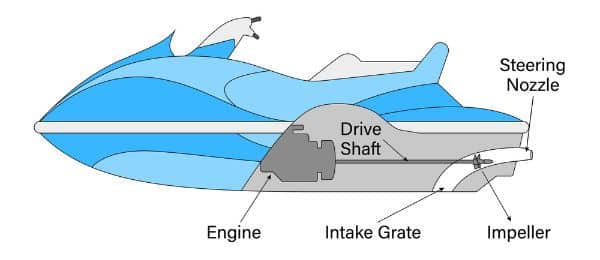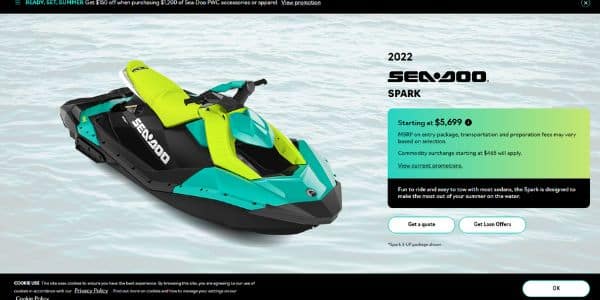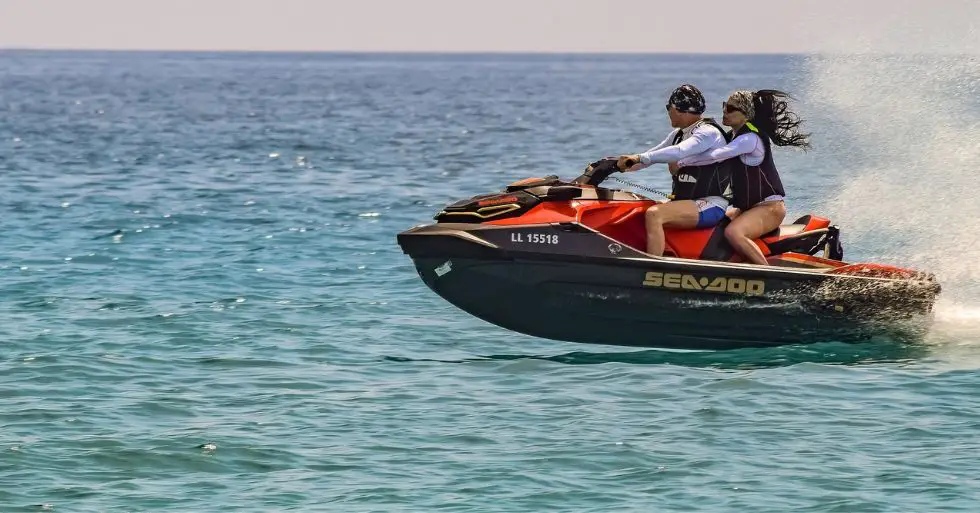Are you looking to find out more information on Jet Skis? You’ve come to the right place. A jet ski is a fun, fast, and agile personal watercraft. It is steered and operated in a completely different way than most watercrafts in terms of both design and functionality. Offering an experience as close to what riding a motorcycle on the water would feel like, jet skis have become increasingly popular in recent years – and for good reason too.
What is a Jet Ski?
A jet ski is a small personal watercraft in which the operator straddles a central platform or seat, and steers with front-mounted grips, similar to those of a motorcycle or snowmobile. They generally seat 2-3 people and can reach speeds of 55-70 mph.
There is a lot to cover when it comes to jet skis, but in this article we’ll go over everything you need to know: what they are, how they function, their history, and some of the most popular types.
A Brief History of Jet Skis

While most people refer to all personal watercraft as jet skis, originally the term had a more specific use. The phrase “Jet Ski” was actually trademarked by Kawasaki in 1973, but it quickly became a term used for all personal watercraft across brands and models.
The first personal watercraft was developed in Europe in the 1950s and was marketed as a “water scooter.” The goal was to take the popularity of scooters, vespas, and motorcycles from the road to the water, but the vision didn’t last. The design of the water scooter was clunky and included an outboard engine.
The idea was forgotten for almost a decade. Sometime in the 1960s, a man by the name of Clayton Jacobsen revisited the water scooter concept. He changed the design from sitting to standup, and also switched the motor from outboard to internal jet pump – hence the name “jet ski.” Jacobsen first pitched his idea to Bombardier, a former snowmobiling company, but they were unsuccessful in taking it to market. He then turned to Kawasaki in 1973, and they turned his concept into a marketable product less than a year later.
The personal watercraft industry sustained constant growth throughout the next two decades. By the 1990s, every major brand was manufacturing a jet ski: Polaris, Arctic Cat, Honda, Yamaha, and Bombardier. The jet ski companies continued to evolve and innovate, producing different variations of the standup and sit-down models to attract new customers.
Difference Between a Wave Runner and Standup Jet Ski
As we’ve already gone over, the personal watercraft evolved to produce two different models. Broadly speaking, the two models are sit-down (wave runner) and standup. However, many people use the two terms interchangeably as they both refer to a personal watercraft. There is much debate amongst watersports enthusiasts about which type of jet ski is better, but the truth is that they both have their own advantages and disadvantages.
Waver Runner Breakdown

The Wave Runner was a term originally coined by Yamaha; the company named their initial watercraft after it. The term has since been used to commonly refer to all personal watercraft, but especially sit-down model jet skis. There are a number of pros and cons when it comes to wave runners.
Pros:
- Comfort: Sit-downs are often considered more comfortable because the smooth ride puts less stress on the operator’s body.
- Speed: While it varies with each model, riders can generally go faster on sit-downs, and sometimes hit speeds upwards of 70 mph.
- Performance: Sit-downs give a more comfortable cruise than standups.
- Selection: Sit-downs are customizable to the customer, with dozens of options on the market that can all be tailor fitted.
- Size: Their size allows for more options. Usually, sit-downs can sit at least 3 people comfortably and are even able to be used for tow sports (tubing, wakeboarding, etc).
Cons:
- Size: This one is both a pro and a con. Their large size can make sit-downs a burden. They are heavier, require more space, and need bigger trailers.
- Price: On average, sit-down jet skis are more costly. However, there are still plenty of affordable options on the market.
- Experience: Sit-downs can go fast, turn sharp, and carry a lot of people, but they still aren’t capable of the tricks, flips, and thrilling experience of a standup.
Standup Jet Ski Breakdown

The main difference here is obvious, and has to do with the standing position of the watercraft operator. Standup Jet Skis are often considered to be more adventurous and entertaining than sit-downs. The following lists details the pros and cons of a standup jet ski.
Pros:
- Price: Generally speaking, standups are cheaper than sit-down models. But this isn’t always the case.
- Size: Their smaller size makes them easier to store and transport. Most standup owners use a small trailer, and some can even transport them in the back of a truck.
- Maintenance: Because they have less display functions and a simpler design, most professionals agree that they are easier to maintain.
- Experience: The biggest pro is the playful, responsive experience that operators can enjoy on a standup jet ski. They’re capable of incredible turning and even backflips – although, tricks that advanced should be left for professionals.
Cons:
- Inclusivity: While you can have multiple people on a sit-down, stand up jet skis are strictly solo watercraft. They also aren’t big enough to tow anybody behind you.
- Barrier to Entry: Their standing nature requires more balance and coordination than sit-downs, which makes them a little harder to learn how to ride.
- Speed: While a stand-up’s speed is less than a sit-down, it can still often go close to 60 mph on smooth water.
What Makes Jet Skis Unique?
Although now they are viewed more as a small boat than a ski, they weren’t originally designed that way. The original concept was to give people the opportunity to “waterski without a boat.” Of course, the jet part of the term came from the unique motor design that shot a jet of water to power the watercraft instead of the traditional propeller used in outboard motors.
Riding or operating a jet ski as opposed to a boat, is a more intimate and thrilling experience. This is where much of the popularity behind the watersport is developed. The operator is able to accelerate quickly with the jet powered motor, make sharp turns, and traverse more volatile water. It’s become a versatile water vehicle that can be used in oceans, bays, lakes, and large rivers.
The final reason behind their popularity is the simplicity of operation. As we’ll go over below, the steps to successfully operate a jet ski are incredibly easy to follow, and most people can learn them in a matter of a few minutes.
How Do Jet Skis Work?
We’ve already briefly mentioned how the jet-propelled engine works, but to reiterate: jet skis move through the water in a similar way to how rockets move through space. It’s a forceful and powerful expulsion that results in a jet stream capable of pushing the vessel across the water at extremely high speeds.
They suck up water threw their impeller, and that is what is used to force it forward. This diagram helps show this:

The operator controls this jet-propelled engine with a throttle similar to ones you may have seen on motorcycles or four-wheelers. It’s a hand-powered throttle located on the right-side of the grip. Jet skis are classified as “automatic” vehicles, and even though they technically don’t have a transmission, they still have forward, neutral, and reverse drive settings.
As far as steering is concerned, jet ski operators are able to use a combination of turning the front-mounted grips and maneuvering their body weight to get the jet ski to move in their desired direction. They are capable of incredibly tight turning, and unlike almost all other vehicles, jet skis actually require significant acceleration to accomplish sharp turns in the water.
How Fast Are Jet Skis?

Most jet skis have a top speed of 55 mph. However, some performance models such as the Sea-Doo RXP-X are able to reach speeds of 70 mph, while some beginner-friendly jet skis, such as the Sea-Doo Spark, only reach 40 mph.
Jet ski size, design, engine size, weight, wind, and water conditions are all factors that determine the top speed of a jet ski. If it’s choppy (above 2-foot waves), expect to lose about 5 mph from the top speed as the jet will have to fight against the waves and sometimes not even be in the water.
Related Article: How Fast Are Jet Skis? (12 Examples Included)
Speed on a jet ski feels way different than speed in a car or even a boat. Believe me when I say 55 mph is plenty fast, and even 40 will blow you away if you’ve never been on a jet ski before. These things a super small accelerating machines that will blow you away with how quick and fast they feel.
Remember there is no window, meaning the wind blowing in your face makes you feel like you’re going way faster than you are. And it’s honestly probably not very safe for inexperienced people to be going any faster than 55 mph on such a small watercraft.
How Much Do Jet Skis Cost?
Most Jet skis cost around $8,000-$17,000 to buy new. However, the most affordable option is the Sea-Doo Spark which only costs $5,700 new. You could save 15%-30% of a jet ski’s original price by just purchasing used jet skis that are a few years old.
Here’s an example of a very affordable new jet ski, the Sea-Doo Spark:

However, most jet skis offered by Sea-Doo cost around $9,000-$15,000, one even starting at $18,000.
When it comes to the used jet ski market, most jet skis don’t actually depreciate that much after the first year. So sometimes you may have to look at jet skis 10+ years old in order to find an affordable one. Buying just 1-3 years old jet skis is also a great way to basically get a new jet ski but get a 15%-30% discount.
Popular Jet Ski Options
Jet skiing is a sport that has grown in popularity for over five decades now. Many watersport enthusiasts are wondering what the best option is for them. The following list will breakdown some of the most popular kinds of jet skis and detail their brand, price, and ideal use.
- Sea-Doo Spark: A well rounded sit-down option for any level of rider. It’s economical, fun, and really forgiving.
- Price Range: $8,769-$12,969
- Horsepower: 60-90hp
- Yamaha EX: A more precise sit-down ride that offers broader performance capabilities. It sports an economical engine, deep storage, comfortable seat, and strong fiberglass hull.
- Price Range: $7,199-$11,699
- Horsepower: 90hp
- Kawasaki STX 160: This jet ski has more power, storage, and size than the ones mentioned above. It’s a great “next-level” option for riders who are looking for advanced maneuvering and excellent performance.
- Price Range: $14,999-$16,799
- Horsepower: 160hp
- Kawasaki Jet Ski SX-R: One of the most popular standup options on the market. This one-person watercraft is designed with a fun and exhilarating experience in mind.
- Price Range: $11,099
- Horsepower: 160hp
Final Thoughts
The insane boom in jet ski popularity didn’t happen by accident. They provide an incredible experience for riders, and prove to be one of the most affordable watercraft options on the market. A jet ski makes for a great addition to your watersports supply if you already own a boat and are looking to add to the fun. At the same time, their wide availability and simplicity make them a great option for anyone looking to get their foot in the door of watersports.
- What Is The Cheapest Way To Store A Boat? - February 28, 2023
- Do Boats Need Bottom Paint? (Uncovering the Truth) - February 2, 2023
- How Much Is Bass Boat Insurance? (Real Quotes) - January 18, 2023

